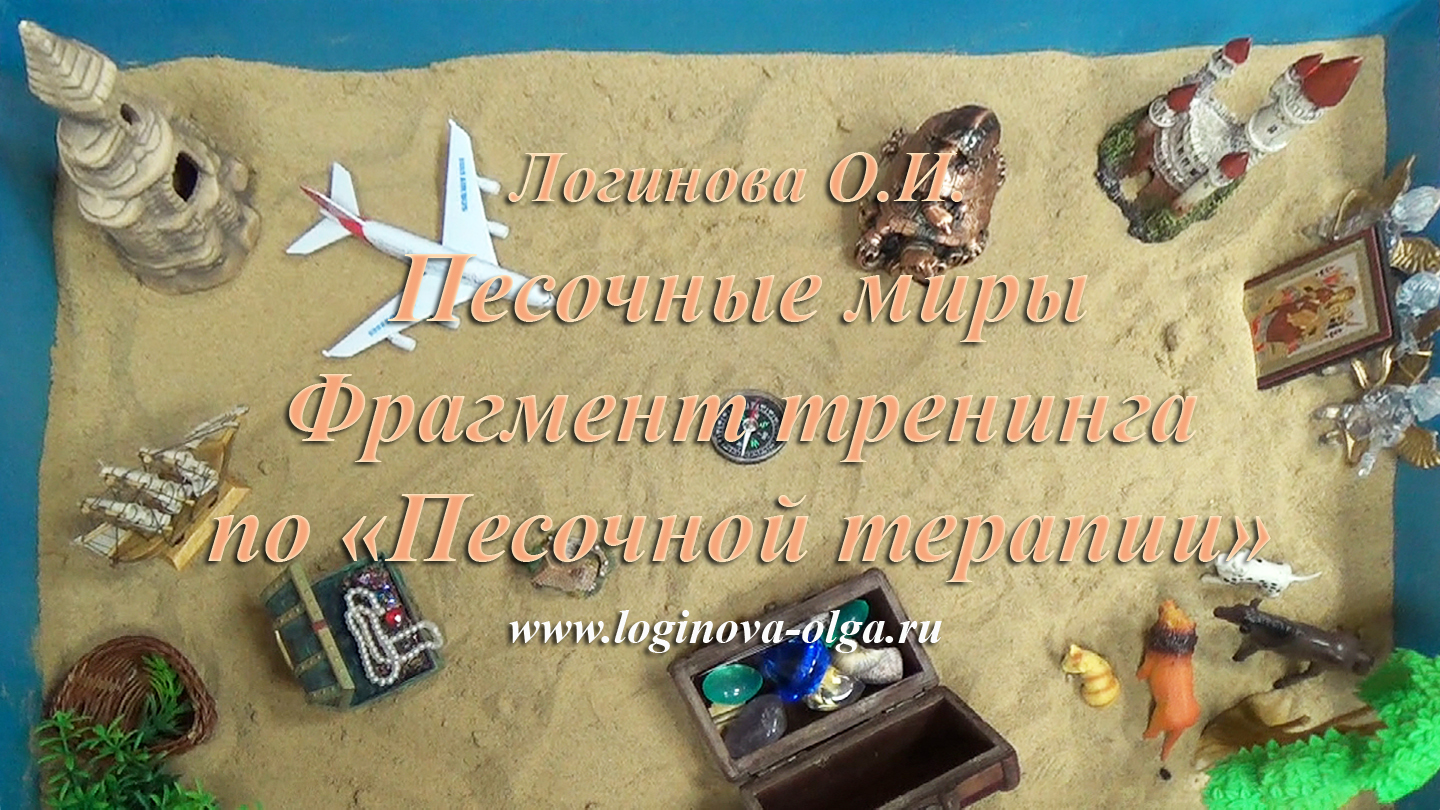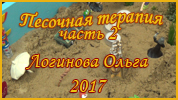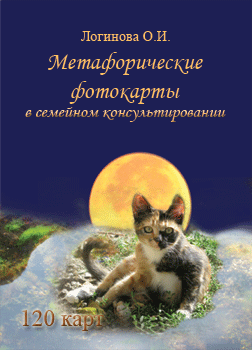Sand Therapy Method
Psychosomatics
Stress
Suicide
Fairytale Therapy
Fairy tales
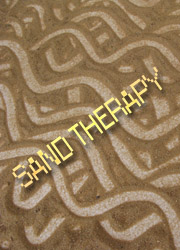
Loginova Olga: Consulting Psychologist specializing in Positive Psychology. Art
Therapist, Trainer of NLP
E-mail:
psycholog50@mail.ru
call at:
+7(916)555-98-10
Russia, Moscow
Articles
Loginova O. I.
The text in Russian and English languages
SAND THERAPY
(Article is published in its short version)
If the human does not want to move and to
grow,
life will force it by any way,
possibly through the tragedy.
Видео. Песочная терапия для взрослых. Фрагмент рабочей видеозаписи. (Февраль
2020 г.)
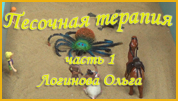
Видео. Песочная
терапия. Часть 1. Работа с агрессией. Фрагмент рабочей видеозаписи. (Сентябрь
2017 г)
Видео. Песочная терапия. Часть 2. Работа с фобиями. Фрагмент записи. (Сентябрь 2017 г)
Видео. Песочная терапия. Часть 3. Работа с мамой особого ребенка. Фрагмент записи (Декабрь 2018 г)
General concept of the sand therapy
The start point for usage of a tray with sand in the psychological practice is believed to be the late 1920s.
Anna Freud, Erik Ericsson and other psychotherapists were using the toys and miniatures in their work with children.
The method of the active imagination developed by C. Jung can be considered as the theoretical base for the sand therapy. Creation of the sand story promotes to the creative regress, work in the sand box throws us back to our childhood and assists to activation of the “kid’s archetype”.
Author of the sand therapy method, the Swiss Jungian analyst Dora Kalff thinks that “the picture on the sand can be understood as the 3 dimensional image of any aspect of the soul state. The unconscious problem is played in the sandbox like the drama the conflict is transferred from the inner world outside and makes it visible”.
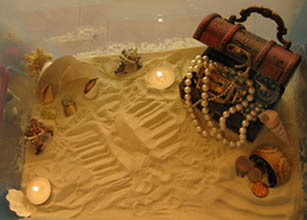 Sand
therapy in the context
of the art-therapy is the non-verbal form of the psychological correction with
the main stress made on the creative self-expression of the client, thanks to
which the
abreaction of the inner tension and
search for the ways of development occur on the unconscious – symbolical level.
Sand
therapy in the context
of the art-therapy is the non-verbal form of the psychological correction with
the main stress made on the creative self-expression of the client, thanks to
which the
abreaction of the inner tension and
search for the ways of development occur on the unconscious – symbolical level.
These images are shown in the symbolical form in the process of creating the creative product – composition of figures and constructions on the tray with sand.
Method is based on combination of the non-verbal (process of composition creation) and verbal expression of the clients (telling about the finished composition, making the story or the fairy-tale, disclosing the composition sense). The sand therapy is successfully applied both for work with the children and with the adults.
In Sweden Charlotte Buhler developed «the world test», which is still used in Sweden as the diagnostic tool in children psychiatry.
The idea to use the sand pays with the patients and psychologically problem children was realized by Margaret Lowenfeld in 1930s. M. Lowenfeld called her technique – World Technique. World Technique was taken from the “world test”.
In 1950s the Jungian psychoanalyst Dora Kalff, after she learned the world technique, started developing the Jungian “Sand therapy” which was later the separate direction in psychotherapy. D. Kalff was initially using the sand therapy with children but later tried it with the adults.
D. Kalff laid the Theory of C.G. Jung to the base of her approach to the sand therapy.
Today the method of the sand therapy is used in art-therapy, gestalt therapy, cognitive and behavior and family therapy, in children psychoanalysis. The sand therapy is a supplement to the other therapy types. Visualization, psychodrama, work with the body and movement, hypnosis etc.
The Jungian sand psychotherapy offers usage of the tray with sand of the standard size and many miniature items.
The difference of the art-therapy practice of work with the sandbox from the traditional usage of the Jungian sand therapy “is the possibility to use the focusing techniques connected with the work with the topics chosen by the client. They can be linked with the enquiry or the actual problem of the client. The significant difference from the traditional variant of the Jungian sand therapy is the usage of the interactive games and exercises.
Application of the focusing techniques connected with the sand therapy with the certain topic, is often caused by the uncertainty and higher anxiety of the client. Under the short-term therapy the specialist can sometimes apply the topical approach.
The main goal of the sand therapy is the achievement by the client of the self-treatment effect by means of the spontaneous creative expression.
The main goal of the sand therapy is the touch with the repressed and suppressed material of the personal unconsciousness, inclusion of it in the consciousness.
Sand therapy capability
This method allows:
To work through the psychologically traumatic situation on the symbolical level.
To abreact the negative emotional experience in the process of the creative self-expression.
Changes to the attitude towards oneself, one’s past, present and future, towards the significant others, in general towards one’s fate.
Assists in regress of the client towards the previous experience with the purpose of the repeated suffering and release.
Is the natural language of the children.
Is the supplement of the other methods of the psycho correcting and psychotherapeutic work.
Technologies of the sand psychotherapy are multifunctional.
They allow the psychologist to resolve the following tasks:
Diagnostic;
Correcting;
Therapeutic;
Of the creative development.
Modifications of the sand therapy can be used in the work of the teachers, speech pathologist and social workers.
Indications for the sand therapy
Sand therapy shall not be used from the first session except for the cases when the client is specially sent for the procedure of the sand therapy.
It is recommended to offer the sand therapy if the client:
Is sent to the psychologist specially for the work;
Cannot explain in words what she/he is feeling or thinking;
Is limited in expression of his/her feelings or is in the state of frustration;
Suffers the existential crisis;
Sharply suffers the age crisis;
Has any psychological traumas;
Has problems with decision making.
Contraindications for usage of the sand therapy
Sand therapy should not be applied in the following cases:
The client features the higher anxiety;
The client has an obsessive –compulsive syndrome (neurosis of the impulsive obsessions) ;
The level of the client’s anxiety is very high.
Allergy and asthma from dust and small particles.
Skin diseases and cuts on hands.
Loginova Olga
Iosifovna
"Metaphoric photo cards
in family consulting".
Practical guidance "How to overcome the crisis in the family"
120 metaphoric cards. Russia,
Moscow, 2015
Symbolism on sand
Symbolism of the sand picture landscape.
Landscape in the sand space symbolizes the map of the client. These can be the mountains, plains, rivers, seas and oceans, roads, forests etc.
Landscape is the reflection of the eventual and sensor experience.
Landscape can show what way this person built for himself/herself and how she/he is going to pass it.
Collection of the miniature items
The sand therapy should offer the great choice of the miniature objects as the small figures will be symbols of the conscious and unconscious processes of the client.
In addition to the miniature figures the office should have the following materials: tissues, threads, laces, clay, modeling clay, colored paper, markers, for the client to be able to create his/her own object missing in the collection.
The collection should contain the miniatures-symbols, attractive and not attractive; fine and ugly; symbols of the good and evil, harmony and absurdity”.
The collection should have the objects of various sizes, colors, structure and materials. They should be:
Large and tiny;
Colorless and of bright colors;
Transparent and non-transparent;
Made of various materials: glass, metal, clay, wood and plastic.
Symbolism of the miniature figures chosen for the sand picture
Figures chosen on the field symbolize what the person has for today. What the authors themselves think of the chosen figures is the most important.
One should remember and understand that there are many people as well as there are many improvisations.
The sand field in the psychotherapist office and the plenty of small figures allow the person to look into their inner space.
Passing by the thousands of figures the person will take in hands only the those ones which are in their subconscious mind, only those ones which are topical for them now and here.
Sandbox in the family therapy
The sand therapy can be used in the family psychotherapy.
When resolving the family problems the therapist can offer to the client or the family couple to choose the figures of those animals which fit for each family member and to create the composition of them on the sand field.
Choosing the figures of the animals the person adds them with the labels or the
metaphor which gives the exact understanding of what is going on in the client’s
family. Basing on the client’s metaphor the psychologist performs the
psychotherapeutic work.
Children sand therapy
The child is offered to play using the sand and toys. Most often they create various forms of the wet sand. The talks and thinking over the picture have no such sense for the children as it would be for the juvenile or the adult. For them the process of play and construction is more important.
John Allan finds in children the general stages of playing with the sands:
«Chaos».
«Struggle».
«Result».
When working with the children we often introduce the rules which are not needed in the work with the adults, we limit or prolong the duration of the session with the sand therapy, allow or specially arrange the presence of the parents or other important adults during the lesson.
In some cases, subject to the resolved issues, we offer to the child and the parent together to construct the world.
Dora Kalff indicated some age aspects in choosing the miniatures.
In the age 6-7 the children have the plants and animals, natural objects prevailing.
By age 11- 12 humans and themes of fights and conflicts appear more often.
The children of age 12-13 start having the scenes reflecting the real life, dreams of future, abstract pictures.
Thus the method of the sand therapy is used in the groups of the personal growth, during the trainings of communication. In the kindergartens, in the centers of corrective and developing education and rehabilitation, in the centers of the off-school work, in the psychological counseling services by the registry offices.
Bibliography
1.Kiseleva М.V. Art-therapy in work with children. Guideline for the children psychologists, pedagogues, doctors and specialists working with the children, Spb.:Rech, 2006. – 160 p.
2. Kopytin А.I., Svistovskaya Е.Е. Guide through the kids’ – juvenile and family art-therapy. Spb.:Rech, 2010. -256 p.
3.Sakovich N.А. technology for sand plays. Plays on the bridge. Spb.:Rech, 2008. -176 p.
4. El G.N. Human playing in sand. Dynamic sand therapy. – Spb.:Rech, 2010. – 2008 p.
5. Internet resources. Materials from Wikipedia – the free encyclopedia. Sand therapy.
Please
e-mail at:
psycholog50@mail.ru
Or call at:
+7(916)555-98-10
®
All rights reserved. The materials of the site may be reproduced partially
or in full only stating the full name of the author(s) of the article.

